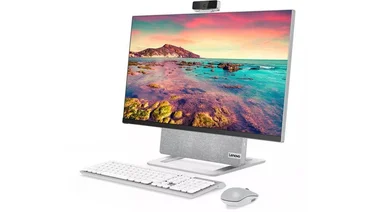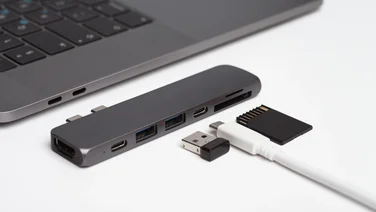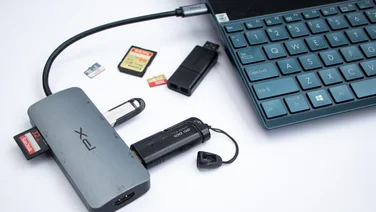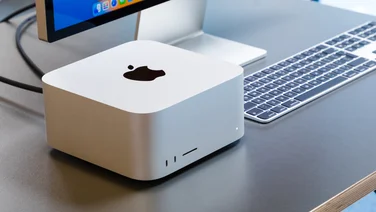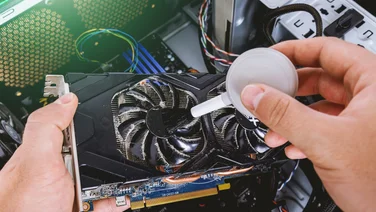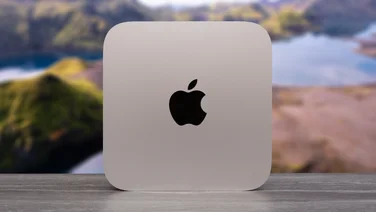To help us provide you with free impartial advice, we may earn a commission if you buy through links on our site. Learn more
- Huawei MateStation X review: What you need to know
- Huawei MateStation X review: Price and competition
- Huawei MateStation X review: Design and build quality
- Huawei MateStation X review: Keyboard, touchpad and webcam
- Huawei MateStation X review: Display and audio
- Huawei MateStation X review: Performance
- Huawei MateStation X review: Verdict












- Huge 4.5K touchscreen
- Stylish and well made
- Great sound system
- Poor webcam
- Inferior mouse
All-in-one computers come in two basic types. On the one hand, you have Windows machines aimed primarily at corporate users who are more worried about the level of discount they can get when buying 500 units for a call centre than looks or features.
On the other hand, you have the Apple iMac, a beautiful piece of technology that can grace even the most stylish of homes or workplaces but has just a slight whiff of form taking priority over function. Huawei has now decided that Windows users deserve a similarly attractive machine but one that still puts practicality to the fore. It’s called the Huawei MateStation X.
Huawei MateStation X review: What you need to know
The Huawei MateStation X is a high-end all-in-one that delivers on all key fronts. What are those? Well, it’s very compact for something with a 28in display, it has a high-quality panel and sound system, a decent array of ports and it looks rather stylish. It’s also powerful thanks to its AMD Ryzen 7 processor.
Like most all-in-ones, the MateStation X is supplied with a keyboard and mouse so you can get going right out of the box. Unlike most other all-in-ones, however, including the Apple iMac, it has a touchscreen that can also be used with a stylus.
READ NEXT: Improve your posture with our best standing desks
Huawei MateStation X review: Price and competition
The MateStation X is available in two models, one built around the octa-core AMD Ryzen 7 5800H processor and the other around the hexa-core Ryzen 5 5600H chip. Both models come with a 512GB SSD for storage and 16GB of DDR4 3200MHz RAM. At the time of writing, the machine wasn’t yet available but, at its launch, a price of €2,199 was quoted for the Ryzen 7 model (with a 1TB SSD), which suggests a UK price in the region of £1,900.
The obvious competition comes in the form of Apple’s 2021-refreshed iMac. A gorgeous bit of kit, it’s surprisingly affordable for something carrying the Apple logo, with the entry-level model yours for under £1,150. It has performance to spare thanks to its M1 processor, while both the display and speaker system are class-leading. The fact it can run iOS games and apps is an obvious attraction to anyone already invested in the Apple mobile ecosystem, but it doesn’t come with a touchscreen like the Huawei.
One of the more interesting-looking all-in-one Windows PCs is Lenovo’s AIO 3 27in machine. For just £750 you get a Full HD display, an AMD Ryzen 7 5800U processor and a 512GB SSD, while the Harman Kardon-certified sound system is a cut above the norm. The canted stand gives the impression the AIO 3 is about to topple over but it’s impressively stable.












The MSI Modern AM241P looks like a mid-price 23.8in monitor and frankly feels like one. It’s a very plastic and uninspired affair and the sample I was sent wouldn’t sit straight, which I thought was pretty poor for something costing more than £1,100. But it does offer a highly adjustable screen and plenty of ports, including HDMI in and out. The speaker system is underpowered, though, and the display is rather dull and lacklustre, making this a machine of more interest to the bulk corporate buyer than the home user.
Finally, the Dell Inspiron 27 is worth a mention, not least because at any given moment there’s usually a good deal to be had on it. At the time of writing, the entry-level Intel Core-i5 model can be yours for £679 rather than the usual £879. One of the few all-in-ones boasting an Ethernet port, the Inspiron 27 also has impressively thin 8mm bezels above and to the sides of the display, a very good speaker system and a funky pop-up webcam. It’s a nice-looking bit of kit, too.
Huawei MateStation X review: Design and build quality
I’m not going to dwell on how much the design of the MateStation owes to the iMac. It’s quite a lot – just take a look at the squared-off edges of the screen – but that doesn’t detract from the Huawei’s impressively elegant and minimalist looks.
Essentially, the MateStation is a big, 10mm thick Windows tablet fixed near the top of a 425mm-tall desktop stand. As with the iMac, there’s no height adjustment and the screen can only be tilted back from the vertical by 20 degrees.
The footprint of the stand is a compact 175 x 185mm, but the pillar that supports the display is much bulkier than the iMac’s slender frame because it houses the speaker system and the system’s USB ports. The latter comprises a pair of USB Type-A Gen 3.1 (5Gbits/sec) ports on the right side of the stand next to the on/off switch and two Type-C Gen 3.1 DisplayPort 1.2 ports on the opposite side above a 3.5mm audio jack.












I think the MateStation’s layout is superior to the iMac’s for two reasons. On purely practical grounds you can access all the ports from your seat and not have to get up and start groping for them behind the screen. And it looks neater because the display has a uniform 8mm bezel all the way around rather than a huge, Desperate Dan chin below it.
I also like that the power cord plugs into the base at the very bottom of the stand, minimising unsightly cable spill. The same goes for the audio jack, which on the iMac is located on the lower left side of the display where it looks rather messy when anything is connected to it.
Flashy design is, of course, no good if the product is made of cheap plastic and sits askew. There are no such worries with the MateStation: it’s as solid as a rock with no sign of wobble. The base is made from a weighty chunk of metal, while the rear of the unibody screen is crafted from aluminium alloy. The perfectly weighted display hinge can be moved by applying one finger to the bottom of the screen, which further enhances the feeling of quality. All this engineering doesn’t make the MateStation a lightweight: at 9kg it’s on the heavy side.
Sadly, Huawei doesn’t offer the same range of colours as Apple, with only two on offer. My review model was the Mystic Silver option, which means a rather plain black and silver colour scheme. I’d go for the darker and funkier grey-and-black Space Grey version if I was buying one.
READ NEXT: The best monitors for you to buy
Huawei MateStation X review: Keyboard, touchpad and webcam
The keyboard that Huawei includes with the MateStation is a good one. A full-sized affair, complete with a numeric keypad, it connects via 2.4GHz wireless and has a silent and positive, if rather shallow, typing action.












Like Apple’s Magic Keyboard, the keyboard comes with a fingerprint reader set into a power button, which means not only does it deliver biometric security but also that you don’t need to lean across your desk to use the power button on the stand. There’s an NFC sensor here, too, to facilitate easy sharing with other Huawei devices. The absence of a backlight is the only real downside to the keyboard’s design.
The bundled Bluetooth mouse (Huawei’s £40 AF30 model), on the other hand, is a rather grim affair that’s uncomfortable to hold and has a glacially slow DPI setting. When Logitech or Microsoft can sell you a much better wireless mouse for under £15 there’s no excuse for Huawei putting this thing in the same box as the MateStation.












Continuing the theme, I’m also less than impressed with the 720p webcam. Images are dull and grainy while the height of the screen means that, unless you have a chair with a lot of vertical adjustment, you’ll forever appear at the bottom of the screen looking up. The four-microphone array works well, though, so you’ll sound great on video calls even if you have to strain your neck to get your face in the centre of the frame.
Huawei MateStation X review: Display and audio
The display, however, is where the MateStation brings home the bacon. The fully laminated gloss finish IPS screen is a big 28.2in 3:2 affair with a resolution of 3,840 x 2,560, which equates to a pixel density of 164ppi. That can’t match the iMac’s 4,480 x 2,520 218ppi but, remember, the iMac only has a 23.5in screen.
The refresh rate is a little bit disappointing at only 60Hz but, other than that, the MateStation’s screen is a triumph. At 555cd/m² it’s impressively bright, while the contrast ratio of 1,266:1 is more than respectable. It’s colourful, too, with 98.8% sRGB coverage and 131% sRGB volume. For the DCI-P3 colour space, those same metrics are equivalent to 92.4% and 92.8%.












You can flip between the sRGB and P3 colour spaces using a control panel accessed by a right-click from the desktop. Whichever you choose, the display is impressively colour-accurate. I measured a Delta E variance of a mere 0.95 in sRGB and 1.45 in P3. Anything below 2 is very good, below 1 is outstanding.
When I started using the MateStation X, I wasn’t sure how much use I was going to make of the 10-point multitouch facility for the simple reason that I thought that, if I was close enough to a 28in monitor to easily touch it, then I’d be too close for the good of my eyesight. After a few days, however, I regularly found myself reaching out to zoom into images or to stop/start media playback, and even reached for my trusty HP MPP stylus for some onscreen doodling. The lack of eye strain may have something to do with the MateStation’s TÜV Rheinland Low Blue Light and Flicker Free certifications.
A glass-covered laminated touchscreen might seem a good recipe for reflections galore but Huawei has applied an anti-glare coating that works surprisingly well. Yes, there are reflections, but even with my patio doors behind me in broad daylight they didn’t detract from what was happening on the screen.
The sound system has been co-engineered with French audio specialists Devialet and consists of two 5W full-range drivers and a 10W subwoofer built into the stand and boy, do they do their job well. Apart from delivering an impressive amount of volume (I recorded an average of 85dB from a pink noise source at 1m and a peak of 92dB during playback of the latest Chvrches album, Screen Violence) the sound is rich, detailed and beautifully balanced. You genuinely won’t need to buy external speakers to get a great audio performance from the MateStation.
One feature that’s a nice bonus is that you can use the MateView as a dumb screen for an external device such as a laptop or desktop PC. This works via DisplayPort and Huawei’s proprietary Display Mode feature within Windows 11, although it took a while to find a cable/laptop that would work. Most didn’t, so it isn’t a feature I’m hugely excited by.
Huawei MateStation X review: Performance
The MateStation X is powered by a 3.2GHz, octa-core AMD Ryzen 7 5800H processor with 16GB of dual-channel RAM. That’s enough to return a score of 295 in our in-house multimedia benchmark, comfortably ahead of the 217 points scored by the 24in Apple iMac. Graphics are handled by the CPU’s integrated AMD Radeon GPU.

When it comes to productivity, the MateStation X can chew through most day-to-day jobs in double-quick time but the absence of a discrete GPU does somewhat limit it when presented with demanding graphics jobs. To prove the point I ran the SPECviewperf 3dsmax benchmark, which at 1,920 x 1,080 scored only 17.8fps. Compare that to the Dell Inspiron Plus’ score of 50.6fps thanks to its Nvidia RTX3050Ti GPU and you get the picture.

If you feel the urge to game, you should also temper your expectations. The 2016 Doom reboot ran perfectly well at around 55fps at 1,280 x 720 but dropped to the low thirties at 1,920 x 1,080 and an unplayable 12fps at display native.
The 512GB SSD performed credibly, though, returning sequential read and write speeds of 3,001MB/sec and 2,187MB/sec respectively. Being a Huawei machine, the drive is divided into a 119GB Windows partition and a 337GB data space, but that’s easy enough to fix.
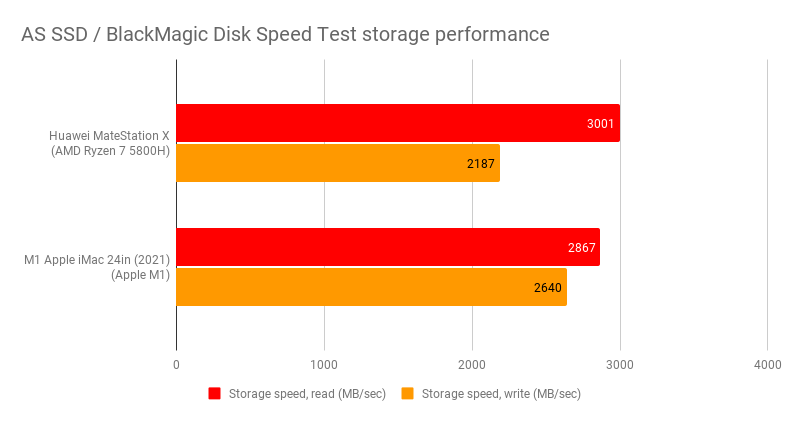
Does the MateStation make much noise while running? Let’s put it this way, I only realised it wasn’t passively cooled when I got to the part of the reviewer’s guide that talked about the design of the 0.3mm thick blades on the “shark fin” fan. So that would be “no”.
The MateStation also features Huawei’s new Super Device drag-and-drop screen-sharing technology. This is a Bluetooth-based feature that lets users connect a HarmonyOS Huawei mobile phone or MatePad tablet with the MateStation to increase screen space or share files and data between devices.
READ NEXT: Our roundup of the best keyboards
Huawei MateStation X review: Verdict
The MateStation X doubles the number of all-in-ones I’d recommend a friend to buy to two, the other being the iMac. The key attractions are the excellent touchscreen display and very impressive speaker system, which combine to make the MateStation an excellent media machine either for consumption or creation.
Add that to the stylish looks, impressive build quality and a good level of performance from the AMD Ryzen 7 chipset and you have a machine that’s hard to find fault with. Just remember to buy a decent mouse.

